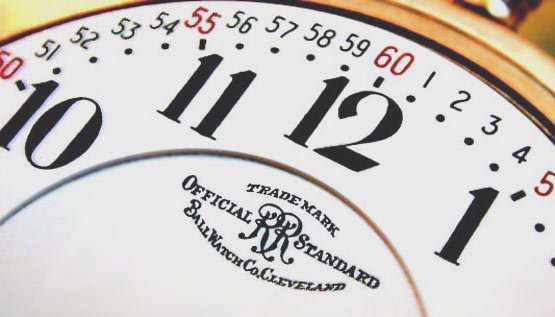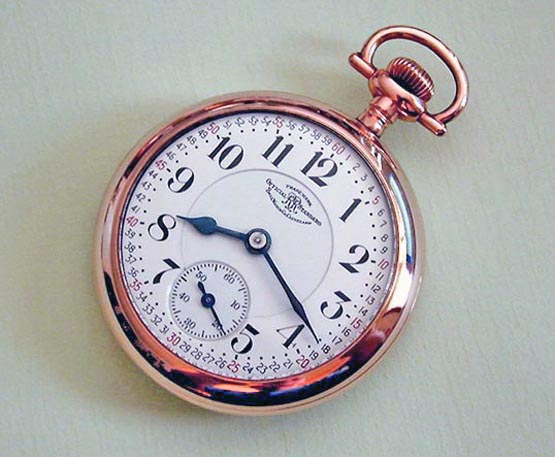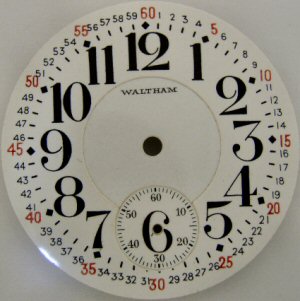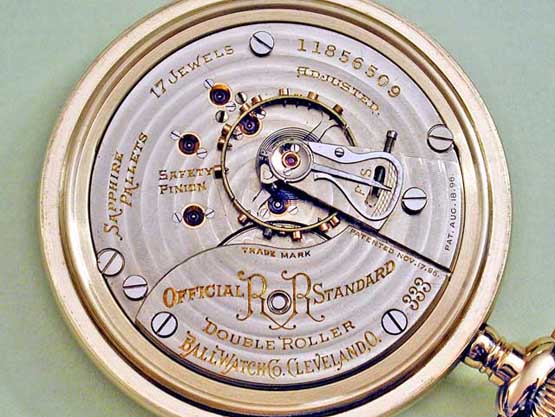
| WWT Shows | CLICK TO: Join and Support Internet Horology Club 185™ | IHC185™ Forums |

|
• Check Out Our... • • TWO Book Offer! • |
Welcome Aboard IHC185™  Internet Horology Club 185
Internet Horology Club 185  IHC185™ Discussion Site Main Page
IHC185™ Discussion Site Main Page  Open to the World RESEARCH FORUMS
Open to the World RESEARCH FORUMS  Ball Watch Company Research Forum
Ball Watch Company Research Forum  BALL ORRS 18-SIZE MARGINAL-MINUTE DIAL!
BALL ORRS 18-SIZE MARGINAL-MINUTE DIAL!
 Internet Horology Club 185
Internet Horology Club 185  IHC185™ Discussion Site Main Page
IHC185™ Discussion Site Main Page  Open to the World RESEARCH FORUMS
Open to the World RESEARCH FORUMS  Ball Watch Company Research Forum
Ball Watch Company Research Forum  BALL ORRS 18-SIZE MARGINAL-MINUTE DIAL!
BALL ORRS 18-SIZE MARGINAL-MINUTE DIAL!Go  | New Topic  | Find-Or-Search  | Notify  | Tools  | Reply to Post  |  |
| IHC President Life Member |
This 18s dial is a favorite of mine, do you see anything unusual here?  | ||
|
I am sure there is something else, but to my eye, the lettering on the dial is all crisp and clear while the edge of the case looks out of focus. I don't think I could focus my camera that way. Andy So many clocks, so little time. | ||||
|
| IHC Member 155 Bulova Watchmaker |
Andy, The point of this picture is the dial, not the picture. If you had Adobe Photoshop you would understand that this picture may have been manipulated to focus attention on the the dial. What is important in this post is what is different about this Ball Dial. I know, who else does? Rich | |||
|
My guess is that this is a Ball dial with Montgomery markings. From what I have read and been told, Mr. Ball and Mr. Montgomery were rivals, and a marriage of these markings on the same dial would be very unlikely or scarce. Mr. Ball liked simple markings that were easy to read. How about showing the seconds dial? | ||||
|
| IHC President Life Member |
Yup, it's all about the dial, both Andy and Rich are right in that I intensified the focus on the dial for emphasis in the image above. Phil, you're on the right track. Webb C. Ball deplored any sort of "marginal minute" dial, he said they were confusing. Ball patented his designs and I'm sure would never agree to pay Montgomery's patent use fee of 25¢ per dial. There are three things about this dial that make it unusual. Just how unusual remains to be seen. Below, here's the entire watch, just as I bought it several years ago...  | |||
|
Double Sunk Ball dials are also unusual. With the addition of the marginal minute (not Montgomery) markings and being as it is double sunk make this one a truly unique and rare item. Cool stuff! Aaron | ||||
|
Waltham Montgomery dial for comparison.  | ||||
|
This is somewhat irrelevant to the discussion, but it's interesting to note (taking account my needing new glasses, badly, and therefore not having great vision), the dimensions of the numerals is quite different between Wayne's and Lindell's dials. Lindell's is set up according to the specs (sort of): sp min sp hr. sp to edge 4% 16% 20% 52% 8% Wayne's is: 10% 20% 10% 45% 15% to edge This more balanced type of spacing may be why Wayne's seems more beautiful, and more readable than the other dial even though there's more space surrounding the hour and the hour number is relatively larger, on Lindell's (assuming I'm anywhere near correct in my readings). This may also suggest that Ball may have failed to understand the visual effects in calling Montgomery's watches illegible. (Also the sideways diamond or box forms that mark the hours, as opposed to simply larger pointer forms on the Ball dial make the hours more visible.) Jessica | ||||
|
Jessica Did you notice the number 6 in the seconds area? The Ball dial with Montgomery markings is very attractive.  | ||||
|
Wayne, To be a true Montgomery Dial, the "6" must be in the seconds register. All other dials without the "6" are marginal minute dials. There was a long discussion about this a while back. Tom | ||||
|
My WAG is an Illinois D/S marginal minute dial with the Ball logo. Sam Williamson | ||||
|
| IHC President Life Member |
There are three things are unusual about the dial shown... Phil was on the right track immediately, then Aaron summed up two of the unusual features perfectly. As a matter of fact very few of the 18s Ball Official RR Standard dials were Double-Sunk. Ball was big on the extra strength of the Single-Sunk Dial, after all it is stronger. The "Marginal Minutes" were also a pet peeve of Webb C. Ball, in fact he was dead set against them. Yes the dial shown above is without question very unusual. Well said Aaron! You solved two-thirds of the mystery. Wayne, I'm with you, I see a really great looking dial on that watch. Now, what is the third feature of this dial that is unusual for 18s ORRS dials? CLUE... Look at pictures of other Ball ORRS dials and compare them carefully! The answer and backup evidence will appear tomorrow in this topic! | |||
|
I don't seem to recall seeing the "Ball Watch Co. Cleveland" marking on the dial. Aren't they simply marked "Cleveland" under the "Official RR Standard"? Aaron | ||||
|
| IHC President Life Member |
You're close Aaron, it does involve what is printed on the dial.. The 18s versions in this era have... "Trade Mark, Official RR Standard, Ball Watch Co., Cleveland" as the signature. This one does have the conventional signature design, but you'll notice that it is unusually large. That and everything else about the dial under discussion above is unusual. The third feature that is remarkably different on this particular dial is the style of numbers 1-12 as they are printed. The dial above does not employ the usual Ball Patented number design. In fact everything but the style of the ORRS Signature is unlike most other 18s Ball Dials. To illustrate the difference, compare the one above with what we see in the next image. Ball Patented numerals on a regular Ball Single-Sunk 18s dial... | |||
|
I noticed the difference in design of the numbers, and was going to mention that as another aesthetic value. I think the Montgomery-Ball is very attractive, don't get me wrong. Other than perhaps the shape of a few numbers, I prefer it aesthetically to the more typical Ball dial. One thought I had, about the relative positioning of the numbers and spaces was that it made the dial more readable even, though more crammed. It seems that Ball had a relatively practical idea: what's larger is more readable (his hour number is quite a bit larger) and what's less crowded with information, and less physically distracting (single vs double sunk) is less confusing. There's a lot to be said for this analysis, even if Montgomery's dial were more aesthetically pleasing (which is subjective). Montgomery had a somewhat different approach, first of all, possibly to the importance of certain information, since, in essence, he gave immediate access to the number of minutes that had passed, rather than several step access (ie with a Ball dial, you tend to think it's between say ten and fifteen; with a Montgomery dial, you know immediately that it's 12). He also had a different view, apparently of information-processing, since his format does not rest on the view that size is the single determinant of visibility, but rather that organization of space, as much as, or more than, sheer size, will shape the ability of the mind to integrate and also distinguish the input of information. I tend to agree with Montgomery, but there's certainly a lot to be said for Ball's simpler, more straight-forward view. Jessica | ||||
|
I did have a couple of questions. First, how do you determine the era to which a dial belongs? And Second, how would you authenticate such an atypical dial, unless it belongs to a well autheticated group of rare or scarce dials. Even then, what steps would you take to be sure that your dial was, in fact, genuine? Jessica | ||||
|
Lindell, can you show us the movement from your watch, too, or tell us what model it is? | ||||
|
| IHC President Life Member |
Jessica and Jerry, As stated above, the third unusual feature of the dial we've been discussing is the numerals, in fact they are very unusual. You see the dramatic difference between the subject dial and the usual Ball ORRS 18-size Dials. But where did these unusual numbers come from, in fact where did the dial design except for the Ball signature come from? The answer will be evident in the response to Jessica's second question and Jerry's follow-up. I very much appreciate the excellent questions. The watch is a Ball-Elgin, and oddly enough the dial has Elgin rather than Ball design characteristics. Was this dial an unsold prototype? Was this dial sent to Ball by Elgin and he rejected it? Like so many situations connected to Ball, we will never know as an absolute fact, but a third generation Ball Employee explained to me that is exactly what he was told happened. It would be interesting to see if any other dials of this same unusual design ever surface. The image below shows the Ball-Elgin and an Elgin 23-Jewel Veritas with remarkably similar dials. The bezels are removed in the image below in order to have a clearer view of the dials. Compare this ORRS dial with Elgin dial from about the same time...  | |||
|
| IHC President Life Member |
All the Ball-Elgins were produced during 1904 and 1905. They fit into a fairly tight range of serial numbers. There is a useful list provided by Ed Ueberall and Kent Singer on page 481 of their August 2002 "Railroaders Corner" article on Ball Watches in the "Bulletin" magazine. Ed and Kent's four-part series is a great stating point for the beginning Ball Watch collector or for anyone interested in learning more about Railroad Watches in general. Jerry, the Ball-Elgin in question is number 11856509 which is about half way through the first run of 17-Jewel Grade 333 movements. Jessica, this one is from 1904 production. Total blocked for the 18-size Open-Face Ball-Elgins were 4,000 of the 17-Jewel and 2,000 of 21-Jewel models. Oddly, Webb C. Ball had these Ball-Elgin movements made in addition to the similar 18-size Ball-Hamiltons during the same time-frame, the reason is open to speculation. Ball-Elgin movement 11856509 behind the unusual Ball ORRS dial...  | |||
|
| Powered by Social Strata |
| Your request is being processed... |
|
Welcome Aboard IHC185™  Internet Horology Club 185
Internet Horology Club 185  IHC185™ Discussion Site Main Page
IHC185™ Discussion Site Main Page  Open to the World RESEARCH FORUMS
Open to the World RESEARCH FORUMS  Ball Watch Company Research Forum
Ball Watch Company Research Forum  BALL ORRS 18-SIZE MARGINAL-MINUTE DIAL!
BALL ORRS 18-SIZE MARGINAL-MINUTE DIAL!
 Internet Horology Club 185
Internet Horology Club 185  IHC185™ Discussion Site Main Page
IHC185™ Discussion Site Main Page  Open to the World RESEARCH FORUMS
Open to the World RESEARCH FORUMS  Ball Watch Company Research Forum
Ball Watch Company Research Forum  BALL ORRS 18-SIZE MARGINAL-MINUTE DIAL!
BALL ORRS 18-SIZE MARGINAL-MINUTE DIAL!©2002-2025 Internet Horology Club 185™ - Lindell V. Riddle President - All Rights Reserved Worldwide

